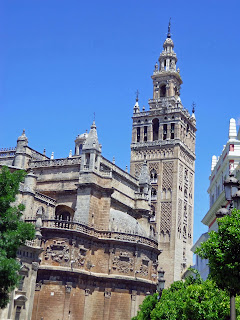
Seville, Granada, Cordoba, Pinto, Eldorado, El Camino, not sure when it happened but at some point in Spain’s history, they started naming their cities after American cars and trucks.

Today we are visiting Seville, one of Cadillac’s most prestigious models and Spain’s 4th largest city. The inhabitants of Seville are known as Sevillinos which I think sounds much cooler than Sevillians and way cooler then Sevillites.
Like many of the cities and towns of southern Spain, Seville has been around for a few centuries. First the Romans, then the Muslims rolled in around the middle of the 8th Century, to be kicked out by the Christians in the 13th Century. It wasn’t till the 15th Century when Seville came into its own when the city was given the monopoly for trade coming from the New World. It was a very lucrative monopoly. It was also here that Ferdinand Magellan set out, to circumnavigate the world. His ship made it but sadly Magellan did not. See the September 17,2009 blog for more details of Magellan’s and us circumnavigating the world

Plaza del Espagna, built in 1928 for the Iberian American Exposition was our first stop. Pleasant little place but just a time killer I think while we waited for the cathedral to open.

Seville Cathedral the world’s largest Gothic church and the world’s 3rd largest church.

Construction began early in the 15th Century and was finished just over 100 years later. The massive dome has collapsed on three occasions with latest one in the 19th Century.
Not a comforting notion as we wandered around this beautiful place.

The massive church giralda (bell tower) stands 343 feet high. The tower actually began life as a minaret for a mosque that stood on the site in the 12th Century. The mosque was repurposed as a church which was then fatally damaged during an earthquake in the 14th. This led to its demolition except for the minaret. The minaret was extended to include a bell tower and incorporated into the construction of the cathedral. There are a still several mosques, that are now churches existing in Spain.
Cristobel Colon (Cristoforo
Colombo, Christopher Columbus) is buried here or so it is claimed. Some claim buried
in the Dominican Republic. The
capital of the Dominican Republic, Santo Domigo claims Columbus’ remains are
buried there in a special crypt called “The Lighthouse” because it is shaped
like a lighthouse.
Comparing DNA from his brother Diego who is also buried in Seville supposedly confirms that the remains in the cathedral are Columbus’. The remains in Santo Domingo may be some of Columbus’, as he died in The New World was moved a number of times before final internment in the cathedral in Seville. They may have left a bit of him there as it was his wish to be buried in the New World. They are now trying to ascertain where he was born. It was thought he was Genoan as claimed by the Italians while the Spanish are claiming he was Catalan. They are now comparing his DNA to men from Catalan and Genoa. Verdicts not in so I will keep you posted.
Comparing DNA from his brother Diego who is also buried in Seville supposedly confirms that the remains in the cathedral are Columbus’. The remains in Santo Domingo may be some of Columbus’, as he died in The New World was moved a number of times before final internment in the cathedral in Seville. They may have left a bit of him there as it was his wish to be buried in the New World. They are now trying to ascertain where he was born. It was thought he was Genoan as claimed by the Italians while the Spanish are claiming he was Catalan. They are now comparing his DNA to men from Catalan and Genoa. Verdicts not in so I will keep you posted.
The Archivo General de Indias contain almost the complete collection of old documents and maps detailing the history of the Spanish Empire in the Americas, everything, from a collection of maps created by the Conquistadores to the journals of Christopher Columbus’ voyages to the New World. Sadly, we could not enter without reservations.
Toro del Oro was the designated the meeting place to catch our bus back to Fuengirola. The tower is one of a number of buildings that still remains from the Moslem conquests. It gets its name from the golden glow of the building when it is hit by the setting sun. It is a dodecagonal military tower built by one of the Moroccan Berber Muslim caliphates that ruled extensive areas of the Iberian Peninsula till the 14th Century.
The tower was used to anchor one end of a huge chain that could be pulled into place across the river to prevent ships from entering the harbour. It is now a tiny naval museum and of course had all the requisite cannons necessary to play with, while we waited for the bus.

















































